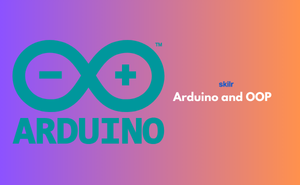👇 CELEBRATE CLOUD SECURITY DAY 👇
00
HOURS
00
MINUTES
00
SECONDS

Arduino is a hands-on electronics platform that helps you build projects by combining hardware and software. With it, people can create devices that sense, react, and interact with the environment. Object-Oriented Programming (OOP) is a coding style that organizes programs into logical units, making development more flexible and professional.
When Arduino is paired with OOP, projects become easier to scale and maintain. Instead of repeating code, you create reusable “blueprints” (classes and objects) to handle specific tasks. This approach saves time, reduces errors, and makes it possible to create advanced systems like automated machines, IoT devices, or smart gadgets with ease.
This exam is ideal for:
Domain 1 - Introduction to Arduino
Domain 2 - Fundamentals of OOP
Domain 3 - Setting Up Arduino and IDE
Domain 4 - Arduino Programming Basics
Domain 5 - Applying OOP in Arduino
Domain 6 - Advanced OOP Concepts
Domain 7 - Hardware Interfacing with OOP
Domain 8 - Practical Projects
Domain 9 - Debugging and Optimization
Domain 10 - Future with Arduino and OOP
Industry-endorsed certificates to strengthen your career profile.
Start learning immediately with digital materials, no delays.
Practice until you’re fully confident, at no additional charge.
Study anytime, anywhere, on laptop, tablet, or smartphone.
Courses and practice exams developed by qualified professionals.
Support available round the clock whenever you need help.
Easy-to-follow content with practice exams and assessments.
Join a global community of professionals advancing their skills.
You will learn both theory and hands-on practical applications.
Growing demand in automation, smart devices, and IoT keeps this highly relevant.
Yes, OOP-based coding makes collaboration easier by organizing tasks.
No, only basic circuit knowledge is enough to start.
Yes, it is valuable for jobs in robotics, IoT, and embedded systems.
Not required, but it helps build cleaner, more advanced applications.
Yes, projects include sensors, actuators, and hardware integration.
Smart sensors, robots, home automation systems, and interactive gadgets.
Yes, this knowledge is a strong foundation for IoT development.
IoT, robotics, automation, prototyping, and consumer electronics.
Yes, it covers both basics and practical applications step by step.
It makes code reusable, scalable, and professional for larger projects.
An Arduino board (like Uno or Mega) and basic electronic components.
Students, hobbyists, engineers, and anyone interested in embedded systems.
Basic C++ knowledge is helpful, but the course introduces OOP fundamentals.